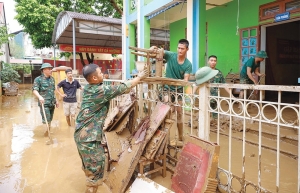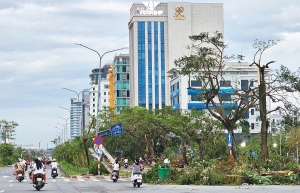Spate of claims made in typhoon aftermath
As of mid-last week, several insurers reported significant property and motor vehicle losses, with compensation estimates running into millions of US dollars.
 |
| Spate of claims made in typhoon aftermath, illustration photo |
Ngo Trung Dung, deputy secretary-general of the Vietnam Insurance Association, said that most insurance payouts related to Typhoon Yagi have involved vehicles damaged by fallen trees or floodwaters, as well as industrial facilities in economic zones.
“These are typically entities that take proactive measures to mitigate risks,” Dung said. “Properties covered by risk insurance, which includes storms, floods, and high winds, as well as motor vehicles with comprehensive insurance, would be eligible for compensation. The widespread devastation from Typhoon Yagi, especially in northern Vietnam’s key economic areas, is expected to result in massive payouts,” Dung said.
Vu Van Thang, deputy CEO of PVI Insurance, said that by September 10, PVI had recorded around 240 claims related to property damage, excluding motor vehicle and personal insurance. The estimated compensation for these claims is expected to exceed $16.7 million.
Thang confirmed that after completing damage assessments, the company would begin issuing advance payments to affected customers within the week.
Similarly, BIDV Insurance reported nearly 500 claims, half of which were related to technical property insurance, while the remainder involved motor vehicles and marine insurance. Total compensation from BIDV Insurance is projected to reach nearly $8.4 million, including losses at a factory in Do Son Industrial Zone in the northern city of Haiphong, which lost its roof during the storm.
PTI Insurance registered 65 claims for property, technical, and marine losses, alongside 273 motor vehicle claims. PTI’s total compensation is expected to exceed $6.3 million, with further updates pending as post-storm flooding continues.
The Insurance Supervisory and Management Department under the Ministry of Finance has confirmed preliminary damage assessments across key insurers. In the technical property insurance sector, 684 claims have been recorded, with Bao Viet Insurance handling 220 cases, VietinBank Insurance 150, PVI 134, and other insurers such as Bao Minh, Agribank Insurance, and PJICO managing the rest.
The motor vehicle sector has reported over 1,000 claims, with Bao Viet Insurance handling 315 cases, PTI 270, and PJICO 220, among others. However, total financial losses have yet to be fully estimated.
Last week, the same department issued a directive urging insurers to work with local authorities and organisations to swiftly assess human and property losses. The directive said insurers should provide advance payments and timely, full compensation to policyholders and beneficiaries, in line with contractual agreements and legal regulations. Insurers were asked to submit damage and compensation reports by September 12.
A representative from PTI said the complexities of property insurance, particularly in relation to mandatory fire insurance for property owners, including factories and residential homes, make some scenarios challenging. While large businesses and industrial facilities tend to be well-insured, small business owners have been severely impacted, with many facing total devastation but lacking coverage.
“Unfortunately, small business owners typically do not prioritise insurance, leaving them unprotected when disaster strikes,” Dung said.
The situation is similar for homeowners. Many residential buildings in northern Vietnam were heavily damaged by Typhoon Yagi, yet few residents had storm or flood insurance for their homes or apartments.
Tran Nguyen Dan, a lecturer at the Ho Chi Minh City University of Economics, said that all-risk property insurance for apartments remains uncommon in Vietnam. He explained that most apartment buyers secure mortgages through banks, which bundle insurance policies that may not meet their actual needs.
“Most people end up buying mandatory fire insurance to cut costs or are pushed into purchasing life insurance through loan agreements with banks. As a result, many apartment owners affected by the recent storm won’t receive compensation despite having insurance,” Dan said.
He further noted that the annual premium for all-risk property insurance for apartments is typically around 3 per cent of the asset’s value – significantly lower than potential financial losses in a disaster.
“Customers and banks should shift focus towards offering and purchasing insurance products that address actual needs rather than transactional insurance bundled with loans,” Dan said.
Dan recommended that policyholders follow these key steps to protect their rights.
“Firstly, immediately contact your insurer to report any damage. If an assessor cannot visit quickly, ask for guidance on documenting the damage, particularly for motor vehicle claims,” he said.
He added that gathering evidence, including photographs, videos, and damage reports, is crucial to facilitate the claims process.
“Finally, policyholders should fully cooperate with assessors during site visits to ensure an accurate record of damage and receive guidance on compensation procedures. Many insurance companies have dispatched professional teams to expedite this process.”
According to the Insurance Business Law, claims must be submitted within one year of the insured event. Any period of force majeure or objective hindrance is excluded from this timeframe. If the contract does not specify a timeline for settlement, insurers are required to provide compensation within 15 days of receiving all valid documents related to the claim.
 | Hanoi endures widespread impact from Typhoon Yagi Typhoon Yagi, which made landfall in Hanoi on September 7, has caused major disruptions to infrastructure in the capital and surrounding areas. |
 | Haiphong picks itself up after typhoon The northern port city of Haiphong has faced severe flooding following Typhoon Yagi, greatly affecting locals and businesses. |
 | Credit support for businesses on offer after Typhoon Yagi The banking sector is sharing the burden with businesses by reducing interest rates on existing loans and providing unsecured credit for new ones to help those affected by Typhoon Yagi. |
What the stars mean:
★ Poor ★ ★ Promising ★★★ Good ★★★★ Very good ★★★★★ Exceptional
 Tag:
Tag:
Related Contents
Latest News
More News
- Non-life insurers face mounting pressure after typhoon hits motor sector (October 02, 2025 | 18:59)
- Prudential Vietnam delivers responsible investment package (September 25, 2025 | 10:37)
- Insurers struggle to keep pace with EV rapid adoption (August 29, 2025 | 17:12)
- Non-life insurance market in sees bright spots in H1 despite rising challenges (August 28, 2025 | 16:21)
- Life insurance rebounds with renewed growth and trust (August 06, 2025 | 18:04)
- Global Care launches Vietnam’s first insurance KOL platform (July 25, 2025 | 09:42)
- Liberty Insurance leaves mark at 2025 Insurance Asia Awards with dual wins (July 14, 2025 | 07:27)
- New CEO takes helm at Prudential Vietnam (July 07, 2025 | 17:51)
- Vietnam's insurance sector reaches turning point for global integration (June 24, 2025 | 09:00)
- Sun Life Vietnam increases charter capital to over $700 million (May 28, 2025 | 19:14)
























 Mobile Version
Mobile Version